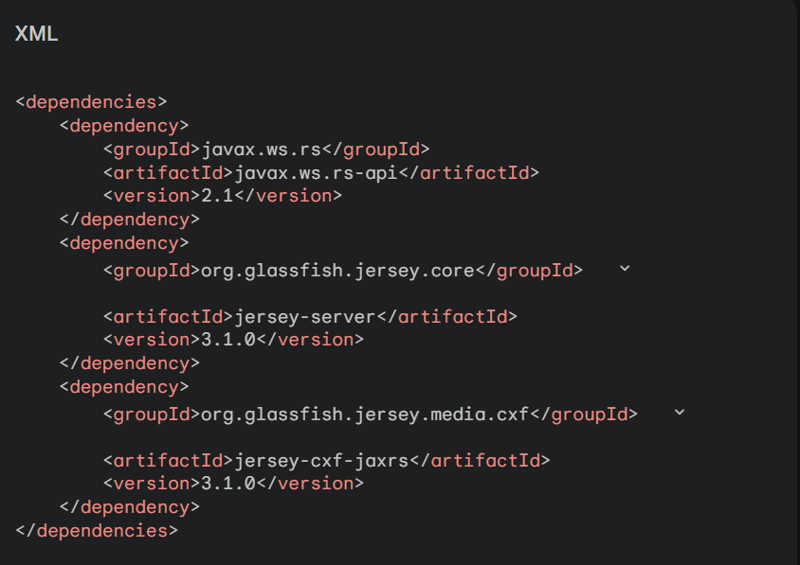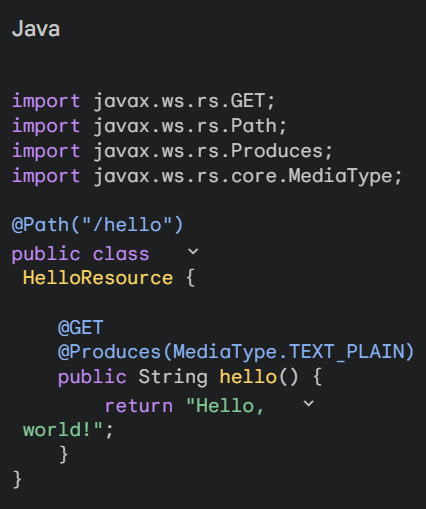Building a RESTful API with JAX-RS and Jersey
RESTful APIs have become an essential component of modern application development. They provide a flexible and scalable way to interact with services and data. In this blog post, we will explore how to build a RESTful API using JAX-RS and Jersey.
What is JAX-RS?
JAX-RS (Java API for RESTful Services) is a Java specification that defines how to create RESTful web services. It provides a set of annotations and interfaces that simplify the development of RESTful APIs in Java.
What is Jersey?
Jersey is a reference implementation of the JAX-RS specification. It provides a complete framework for building RESTful APIs in Java. Jersey includes features such as client and server-side components, support for various HTTP methods, and integration with other Java technologies.
To create a RESTful API with JAX-RS and Jersey, we will follow these steps:
- Create a Maven project
- Add JAX-RS and Jersey dependencies
- Create a RESTful resource class
- Deploy the API
**Step 1:
Create a new Maven project and add the following dependencies to the pom.xml file:

Step 2: Create a RESTful resource class
Create a Java class that represents a RESTful resource. Annotate the class with @Path to specify the base path for the resource. Use annotations like @GET, @POST, @PUT, and @DELETE to define HTTP methods that can be used to access the resource.
Here is an example of a RESTful resource class:

Step 3: Deploy the API
To deploy the API, create a web.xml file and add the following configuration:
XML

JAX-RS provides a standard way to create RESTful APIs in Java, while Jersey offers a complete framework for building and deploying RESTful APIs.
-
 How Many Digits Are in an Integer in Python?Counting the Number of Digits in an IntegerIn Python, integers do not have an intrinsic concept of length. However, if you need to determine the numbe...Programming Published on 2024-11-09
How Many Digits Are in an Integer in Python?Counting the Number of Digits in an IntegerIn Python, integers do not have an intrinsic concept of length. However, if you need to determine the numbe...Programming Published on 2024-11-09 -
 Java Thread Pool: How to Efficiently Manage Threads1. Introduction to Thread Pool in Java 1.1 What is a Thread Pool? A thread pool is a group of pre-instantiated reusable threads that ...Programming Published on 2024-11-09
Java Thread Pool: How to Efficiently Manage Threads1. Introduction to Thread Pool in Java 1.1 What is a Thread Pool? A thread pool is a group of pre-instantiated reusable threads that ...Programming Published on 2024-11-09 -
 Web Development Trends to Watch in 4As we step into 2024, the landscape of web development continues to evolve at an unprecedented pace. From new technologies to changing user expectatio...Programming Published on 2024-11-09
Web Development Trends to Watch in 4As we step into 2024, the landscape of web development continues to evolve at an unprecedented pace. From new technologies to changing user expectatio...Programming Published on 2024-11-09 -
 How to Create Custom Helper Methods in Laravel Without Facades?Custom Helper Methods in Laravel without FacadesIn Laravel, helper methods like myCustomMethod() are widely used for extending application functionali...Programming Published on 2024-11-09
How to Create Custom Helper Methods in Laravel Without Facades?Custom Helper Methods in Laravel without FacadesIn Laravel, helper methods like myCustomMethod() are widely used for extending application functionali...Programming Published on 2024-11-09 -
 Can I Restore My MySQL Database with Only .frm Files?Retrieving Data from .frm Files for MySQL Database RestorationYou've realized that your weekly table dumps only include .frm files, leaving you wi...Programming Published on 2024-11-09
Can I Restore My MySQL Database with Only .frm Files?Retrieving Data from .frm Files for MySQL Database RestorationYou've realized that your weekly table dumps only include .frm files, leaving you wi...Programming Published on 2024-11-09 -
 Understanding Node.js Streams: What, Why, and How to Use ThemNode.js Streams are an essential feature for handling large amounts of data efficiently. Unlike traditional input-output mechanisms, streams allow dat...Programming Published on 2024-11-09
Understanding Node.js Streams: What, Why, and How to Use ThemNode.js Streams are an essential feature for handling large amounts of data efficiently. Unlike traditional input-output mechanisms, streams allow dat...Programming Published on 2024-11-09 -
 Please provide me with the article so I can generate a suitable question-based title.Styling theProgramming Published on 2024-11-09
Please provide me with the article so I can generate a suitable question-based title.Styling theProgramming Published on 2024-11-09 -
 NPM peerDependencies in Depth: A Comprehensive IntroductionAs Javascript developers, we all know two different dependencies in our projects, dependencies and devDependencies, but what about peerDependencies? I...Programming Published on 2024-11-09
NPM peerDependencies in Depth: A Comprehensive IntroductionAs Javascript developers, we all know two different dependencies in our projects, dependencies and devDependencies, but what about peerDependencies? I...Programming Published on 2024-11-09 -
 How to Sum Specific DataFrame Rows in Pandas?How to Sum DataFrame Rows for Specific Columns in PandasFor a given DataFrame, it can be necessary to calculate the sum of values across specific rows...Programming Published on 2024-11-09
How to Sum Specific DataFrame Rows in Pandas?How to Sum DataFrame Rows for Specific Columns in PandasFor a given DataFrame, it can be necessary to calculate the sum of values across specific rows...Programming Published on 2024-11-09 -
 What is PATH_INFO in PHP and how does it work with Apache?PATH_INFO in PHP: Unveiling the MysteryThe PATH_INFO variable has been encountered in various contexts, but its true nature remains elusive. To gain a...Programming Published on 2024-11-09
What is PATH_INFO in PHP and how does it work with Apache?PATH_INFO in PHP: Unveiling the MysteryThe PATH_INFO variable has been encountered in various contexts, but its true nature remains elusive. To gain a...Programming Published on 2024-11-09 -
 How to Force Browser Refresh for CSS, JavaScript, and More?Forcing Browser to Refresh CSS, JavaScript, and More: A Comprehensive GuideWhen developing with WordPress through XAMPP, you may encounter delays when...Programming Published on 2024-11-09
How to Force Browser Refresh for CSS, JavaScript, and More?Forcing Browser to Refresh CSS, JavaScript, and More: A Comprehensive GuideWhen developing with WordPress through XAMPP, you may encounter delays when...Programming Published on 2024-11-09 -
 React module => No FrameworkMy experience with React and gaming challenge which is put me int to flow: if I was select jsDoc to eliminate language dependency (TS) from my code. N...Programming Published on 2024-11-09
React module => No FrameworkMy experience with React and gaming challenge which is put me int to flow: if I was select jsDoc to eliminate language dependency (TS) from my code. N...Programming Published on 2024-11-09 -
 How to Efficiently Remove Trailing Zeros from Decimal Numbers in PHP?Removing Trailing Zeros from Decimal Numbers in PHPIn PHP, removing trailing zero digits from decimals can be a common task. Consider the following sc...Programming Published on 2024-11-09
How to Efficiently Remove Trailing Zeros from Decimal Numbers in PHP?Removing Trailing Zeros from Decimal Numbers in PHPIn PHP, removing trailing zero digits from decimals can be a common task. Consider the following sc...Programming Published on 2024-11-09 -
 Why does SimpleDateFormat.parse output differently than specified when converting UNIX timestamps to dates?SimpleDateFormatter.parse Outputs Differently Than SpecifiedWhen converting UNIX timestamps to dates using SimpleDateFormat, you may encounter discrep...Programming Published on 2024-11-09
Why does SimpleDateFormat.parse output differently than specified when converting UNIX timestamps to dates?SimpleDateFormatter.parse Outputs Differently Than SpecifiedWhen converting UNIX timestamps to dates using SimpleDateFormat, you may encounter discrep...Programming Published on 2024-11-09 -
 How can I Reliably Detect Device Rotation in a Browser on Android with JavaScript?Detect Device Rotation in Browser on Android with JavaScriptCompatibility Challenges in Detecting RotationDetecting device rotation using JavaScript i...Programming Published on 2024-11-09
How can I Reliably Detect Device Rotation in a Browser on Android with JavaScript?Detect Device Rotation in Browser on Android with JavaScriptCompatibility Challenges in Detecting RotationDetecting device rotation using JavaScript i...Programming Published on 2024-11-09
Study Chinese
- 1 How do you say "walk" in Chinese? 走路 Chinese pronunciation, 走路 Chinese learning
- 2 How do you say "take a plane" in Chinese? 坐飞机 Chinese pronunciation, 坐飞机 Chinese learning
- 3 How do you say "take a train" in Chinese? 坐火车 Chinese pronunciation, 坐火车 Chinese learning
- 4 How do you say "take a bus" in Chinese? 坐车 Chinese pronunciation, 坐车 Chinese learning
- 5 How to say drive in Chinese? 开车 Chinese pronunciation, 开车 Chinese learning
- 6 How do you say swimming in Chinese? 游泳 Chinese pronunciation, 游泳 Chinese learning
- 7 How do you say ride a bicycle in Chinese? 骑自行车 Chinese pronunciation, 骑自行车 Chinese learning
- 8 How do you say hello in Chinese? 你好Chinese pronunciation, 你好Chinese learning
- 9 How do you say thank you in Chinese? 谢谢Chinese pronunciation, 谢谢Chinese learning
- 10 How to say goodbye in Chinese? 再见Chinese pronunciation, 再见Chinese learning

























